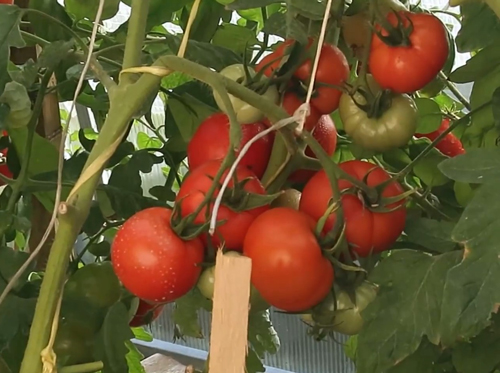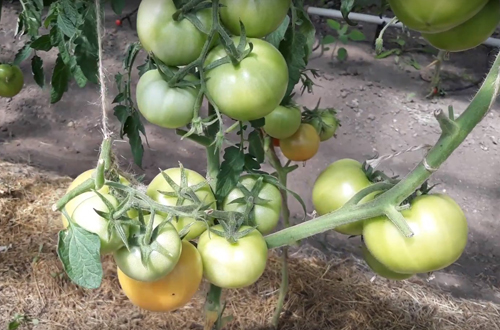Tomato variety Lyrica (F1)
It is not the first time that a very young but rapidly developing seed-growing company "Partner" surprises with beautiful tomato varieties and hybrids. And now another replenishment in the family of early ripe tomatoes, which bears the poetic name Lyrica. In 2016, the new product was announced by TK Leader LLC. Originator - V.I. Blokin-Mechtalin. In 2018, the variety was included in the State Register of Breeding Achievements of Russia. After variety trials, it is recommended for cultivation in all regions of the country, which already speaks of the high adaptability of the tomato. The species can be cultivated in the open field or under film shelters in personal subsidiary plots. The lyrics refer to hybrids, so the seed should always be labeled F1.

Description
The appearance of the plant leaves only a positive impression. Determinate bush, very compact. Regardless of the growing conditions, the maximum height is limited to 70 cm. Shoot formation and leafiness in the variety are moderate. The stem and shoots are not very powerful, covered with glandular hairs. The internodes are short, which guarantees frequent inflorescence. Leaves are green, slightly wrinkled, dull, of the usual type. The inflorescences are of a simple type. A feature of the variety is the frequent formation of fruit clusters. The first is laid over 4 - 5 sheets. And then the brushes appear not only in every leaf node, but also in almost every internode. But it should be said right away that not all plants have such an effect, but most of them. Fruit clusters are well filled, 5 - 7 ovaries are formed in them, although there may be more flowers. Basically, all tomatoes are one-dimensional, but in the first cluster, larger specimens can ripen. The peduncle is strong, with articulation.
The fruits of the variety are round or flat-round, dense, elastic, thick-walled. A feature of Lyrica is a wide ribbing of the surface, clearly visible in an unripe tomato. In the process of ripening, the folds are poured and smoothed, and so-called lush shoulders or cheeks appear near the stalk. The color of an unripe tomato is light green, there is no dark spot at the stalk. Ripe fruit is filled with a rich red color. The skin is thin, but firm, glossy and shiny. A pistillate scar is visible at the top. The pulp is red, very fleshy, tender, juicy, rather dense (somewhat denser than that of the Lyubasha hybrid), aromatic. There are 4 - 6 seed chambers, they are medium or large, well filled, there are not too many seeds. The originator indicates the taste as very good, the taste is sweet, with a slight sourness. The State Register also notes good taste. If we compare with Lyubasha, then our heroine still has a slightly sourness. But between tomato growers, as always, there is a dispute about the taste of early-ripening tomatoes. Of course, the taste qualities of the described hybrid do not reach the varietal crops grown in an open garden under the sun, but among the early maturing species they definitely stand out for the better. The mass of a tomato, according to the State Register, is 140 grams. The originator claims a weight between 100 and 150 grams.

Variety characteristics
- The lyrics belong to the early maturing varieties. But growing conditions can affect this feature - reduce or slightly increase the ripening period. Indoors, picking ripe tomatoes can begin as early as 80 days after the first cotyledon leaves appear in seedlings. On a street bed, this will happen in 90 to 95 days;
- despite its short stature, the plant has a high yield, which some tall crops can envy. The State Register provides data on 15.3 - 16.5 kg, collected from 1 square meter under film shelters. The originator claims 20, and even 25 kg from the same area, and, as noted, such a result is possible both indoors and outdoors. Thus, it can be calculated that 1 bush brings 5 - 6 kg. Tomato growers claim 4 - 4.5 kg per plant;
- growing a variety in greenhouse conditions, a vegetable grower can count on a friendly return of the harvest, as a result of which Lyrica can be used in repeated circulation;
- ripe tomatoes do not fall off the brushes;
- the skin perfectly protects ripe tomatoes from cracking even at high humidity;
- the immunity of the variety is excellent throughout the growing season. The species is resistant to top rot, tolerant to tobacco mosaic virus and Alternaria. Thanks to the early and amicable ripening of the crop, Lyrica manages to get away from fusarium;
- if the variety is grown in unprotected soil in cool regions, then the crop can be harvested at the stage of blanche ripeness. Fruits ripen well in indoor conditions for several days;
- the adaptability of the plant to unfavorable weather conditions is good. And a low growth will allow, in the event of a sharp drop in temperature, to easily hide tomato bushes under a film cover;
- excellent transportability - elastic tomatoes will not wrinkle and will not lose excellent marketability, which is very important when growing products for sale;
- keeping quality also does not fail. At temperatures from + 2 ° C to + 10 ° C, the crop will lie without loss of appearance and taste for 2 - 3 weeks;
- the method of consumption, like most early-ripening varieties, is salad. But the dense consistency, the right size and strong skin allow the excess of Lyrica's crop to be used in whole-fruit canning. Also, the fruits can be salted, pickled, processed into a paste, used in cooking.
Agrotechnics
The described hybrid is not recommended to be planted by direct sowing of seeds into the soil. For early ripening, you need to plant pre-grown tomato seedlings. The preparation of seeds and the cultivation of seedlings is carried out according to the standard scheme. Seedlings ready for transplantation should be about 55 - 60 days. Calculate the sowing time taking into account the growing conditions. The recommended planting density is 4 pieces per 1 square meter in a greenhouse, and no more than 5 pieces per 1 square meter. meter outside. Plants are recommended to be tied to a support, otherwise weighty ripening brushes can outweigh and bend the stem. In a greenhouse, the variety can be formed in 3 - 4 stems, sometimes it is allowed to form in 5 stems. On an open bed, Lyrica is formed into 2 - 3 stems, so that the crop has time to fully ripen on the bush. Although it has been experimentally proven that even in 4 stems (but only in warm regions), you can get remarkable results. Pickling is done in moderation or not at all. Further care for tomatoes is not difficult. Watering in the greenhouse and outdoors is carried out as the topsoil dries up. On an open bed, natural precipitation must be taken into account. Top dressing is applied mainly by universal ones with a balanced composition. Weeding and loosening the soil after watering are also standard agricultural techniques.
Lyrica is an excellent variety for open beds or greenhouses. The peculiarity of this variety is that in a greenhouse and in an open garden, it always gives an equally high yield. In protected ground, the yield can be higher than a little over a kilogram, but tomatoes grown under the real sun have the best taste. Resistance to fungal and viral diseases will allow less frequent use of garden chemistry, so the crop can be environmentally friendly and be really beneficial to health. The fruits are equally good natural and processed. No critical shortcomings were revealed during the cultivation period. The only big disadvantage of the hybrid is the still high price of seed material and the need for constant purchase of seeds.








